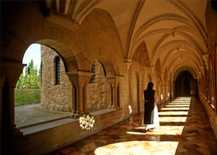
Locality: TULEBRAS (31522)
Address: Calle San Bernardo s/n
Zone: The Ribera
Style: Romanesque
Centuries of construction: XII
Visiting hours: Fines de semana de 16:00 a 18:00.
Price of the visit: La voluntad
Telephones: 948851475 – 676186734
Fax: 948850012
Description
Amidst fields of crops on the banks of the river Queiles, next to the houses that make up the hamlet of Tulebras in the Ribera (southern) region of Navarre, stands the Monastery of Santa María de la Caridad, the first convent that the Cistercians founded in Spain. Since its construction in the twelfth century it has housed the monastic life of the nuns, who undertook its renovation a few years ago.
The search for purity and the fundamental through forsaking any superfluous adornment is a principle of the Cistercians, and is achieved to perfection in this convent. The church, the cloister, the abbatial palace, the museum and the remains of an old Roman tower are major elements of the heritage that has been preserved.
Touring it in silence will give you a wonderful sense of serenity and introspection while at the same time revealing a fascinating collection of religious art. The first nunnery in Spain, dedicated to Santa María de la Caridad, was initially founded in Tudela in 1149 under the name of Santa María de las Dueñas and in 1157 it was transferred to Tulebras, a hamlet of barely 100 inhabitants located three kilometres from Cascante. Its era of glory coincided with the twelfth century, but decline came between the fourteenth and fifteenth centuries with the destruction of the hamlet by the Castilians, including the monastery.
Guided Visit
A guided visit of the monastery will introduce you to the church, the cloister and the abbatial palace. The Cistercian church, dating from the twelfth century, has a single nave and a semicircular apse with a stellar vaulted ceiling, built in the sixteenth century to replace the earlier one. Observe the huge altar table from the thirteenth century and the image of the Virgin of Charity, in Gothic style (14th century), and on the outside take a close look at the small Romanesque door on the Evangelist side.
Stroll peacefully in silence through the cloister, built in the sixteenth century, which still has its groined vaulting. The abbatial palace, built in the 19th century in Baroque style with a brick façade, displays an attractive alabaster coat of arms above the main door.
The museum, standing next to the church, has an interesting collection of sacred art from the 16th, 17th and 18th centuries. Some of the treasures housed there include valuable carvings, paintings, altarpieces, furniture and pieces of silverwork, a painting of the Holy Trinity, by Jerónimo Cósida, and the painted altarpiece featuring the Sleep of the Virgin in an unusual and original representation of this biblical passage.
The nuns, who guide the tour of the monastery, make delicious home-made pastries which are on sale together with traditionally-produced honey and natural cosmetics.







